Issue Archive
Table of Contents
EDITORIAL
Introduction to a review series on inherited anemias
In this commissioned Review Series introduced by Associate Editor Mario Cazzola, experts review the biology and pathophysiology of prominent inherited anemias and provide updated information on their management.
BLOOD COMMENTARIES
REVIEW SERIES
Inherited Anemias
Glucose-6-phosphate dehydrogenase deficiency
In this commissioned Review Series introduced by Associate Editor Mario Cazzola, experts review the biology and pathophysiology of prominent inherited anemias and provide updated information on their management.
Management of pyruvate kinase deficiency in children and adults
In this commissioned Review Series introduced by Associate Editor Mario Cazzola, experts review the biology and pathophysiology of prominent inherited anemias and provide updated information on their management.
Red cell membrane disorders: structure meets function
In this commissioned Review Series introduced by Associate Editor Mario Cazzola, experts review the biology and pathophysiology of prominent inherited anemias and provide updated information on their management.
Diamond-Blackfan anemia
In this commissioned Review Series introduced by Associate Editor Mario Cazzola, experts review the biology and pathophysiology of prominent inherited anemias and provide updated information on their management.
Congenital dyserythropoietic anemias
In this commissioned Review Series introduced by Associate Editor Mario Cazzola, experts review the biology and pathophysiology of prominent inherited anemias and provide updated information on their management.
CLINICAL TRIALS AND OBSERVATIONS
Impact of Myc in HIV-associated non-Hodgkin lymphomas treated with EPOCH and outcomes with vorinostat (AMC-075 trial)
Clinical Trials & Observations
Ramos and colleagues report a randomized phase 2 trial of the addition of vorinostat to the EPOCH regimen in HIV-associated non-Hodgkin lymphoma, aiming to reduce latent HIV reservoirs and improve responses. Their data indicate that while EPOCH has broad efficacy, there are inferior outcomes with Myc-overexpressing lymphomas, and vorinostat adds toxicity without improving complete response rates or reducing latent HIV reservoirs.
LYMPHOID NEOPLASIA
MYELOID NEOPLASIA
Aldehyde dehydrogenase 3a2 protects AML cells from oxidative death and the synthetic lethality of ferroptosis inducers
Yusef and colleagues identified new metabolic vulnerabilities in acute myeloid leukemia (AML) in an ex vivo screen. They highlight a leukemia-specific dependency on aldehyde dehydrogenase 3a2 and the ability of depletion of this enzyme to potentiate killing by inducers of ferroptosis and standard chemotherapy.
PLATELETS AND THROMBOPOIESIS
Platelet gene expression and function in patients with COVID-19
Using RNA sequencing, Manne and colleagues found altered gene expression profiles in pathways associated with ubiquitination, antigen presentation, and mitochondrial dysfunction in platelets from patients with COVID-19. They also found an increase in platelet activation and aggregation that may contribute to the clinical features of the illness.
Platelet activation and platelet-monocyte aggregate formation trigger tissue factor expression in patients with severe COVID-19
Hottz and colleagues demonstrate that the platelets of critically ill patients with COVID-19 exhibit increased platelet and platelet-monocyte aggregation in comparison with those from patients with mild infection. They also reveal that platelets from patients with COVID-19 induce monocyte tissue factor expression through P-selectin and integrin αIIb/β3 signaling.
THROMBOSIS AND HEMOSTASIS
Postdischarge thrombosis and hemorrhage in patients with COVID-19
Clinical Trials & Observations
Brief Report
In these 2 independent studies from Boston and London, the authors report cohort studies that suggest, respectively, that there is no significant increase in the risk of postdischarge thrombosis and bleeding or of venous thromboembolism specifically after admission for COVID-19, compared with that associated with other acute medical illnesses.
Postdischarge venous thromboembolism following hospital admission with COVID-19
Clinical Trials & Observations
Brief Report
In these 2 independent studies from Boston and London, the authors report cohort studies that suggest, respectively, that there is no significant increase in the risk of postdischarge thrombosis and bleeding or of venous thromboembolism specifically after admission for COVID-19, compared with that associated with other acute medical illnesses.
TRANSFUSION MEDICINE
HIV antiretroviral therapy and prevention use in US blood donors: a new blood safety concern
Custer and colleagues used 3 different metrics to demonstrate that HIV-positive people on antiretroviral therapy and individuals taking HIV preexposure prophylaxis are donating blood. Although the implications for blood safety are currently unknown, both scenarios potentially increase the risk of transfusion-transmitted HIV if drug therapy suppresses viremia and/or antibody levels below the levels detected by current screening assays.
HIV incidence in US first-time blood donors and transfusion risk with a 12-month deferral for men who have sex with men
Grebe et al investigated whether changing the US blood donation policy for men who have sex with men from an indefinite deferral to a deferral of 12 months from last sex increases the risk of transfusion-transmitted HIV. They found no significant difference in the risk of HIV transmission by transfusion.
LETTER TO BLOOD
Increased prevalence of BRCA1/2 mutations in women with macrotextured breast implants and anaplastic large cell lymphoma of the breast
Clinical Trials & Observations
BLOOD WORK
ERRATUM
-
Cover Image
Cover Image
![issue cover]()
Light microscopy analysis of bone marrow from a patient with congenital dyserythropoietic anemia type IV, showing trinucleated erythroblasts. See the article by Iolascon et al on page 1274.
- PDF Icon Front MatterFront Matter
- PDF Icon Table of ContentsTable of Contents
- PDF Icon Editorial BoardEditorial Board
Advertisement intended for health care professionals
Email alerts
Advertisement intended for health care professionals


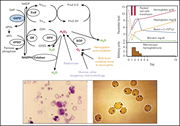
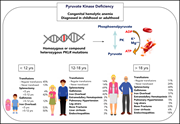


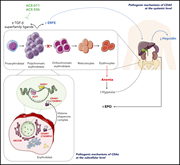




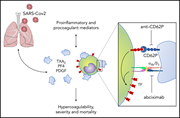
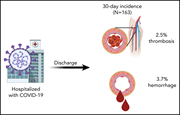
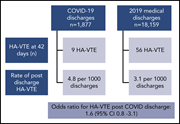

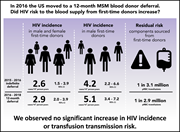

Myc matters in HIV-associated lymphoma
Clinical Trials & Observations